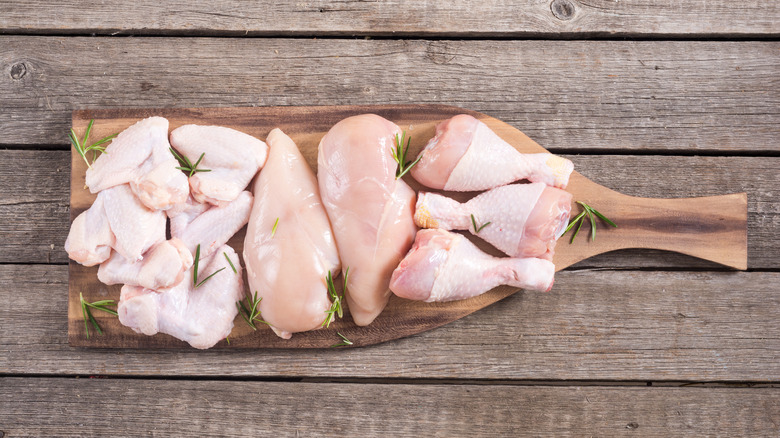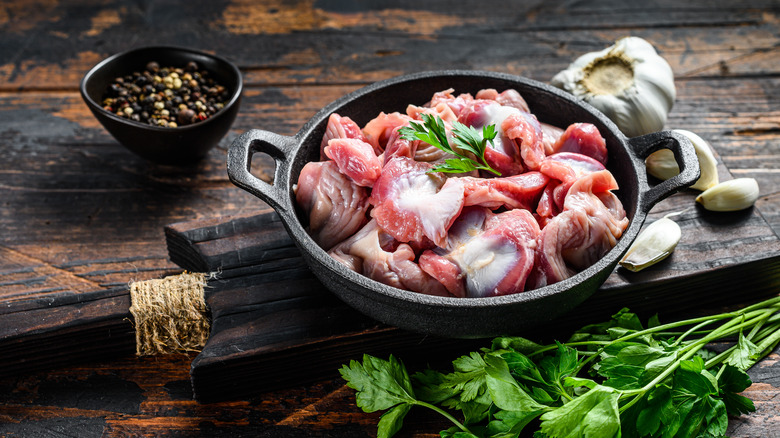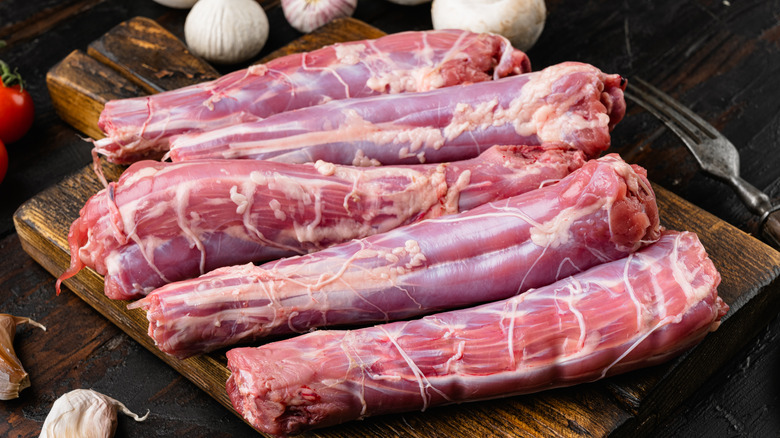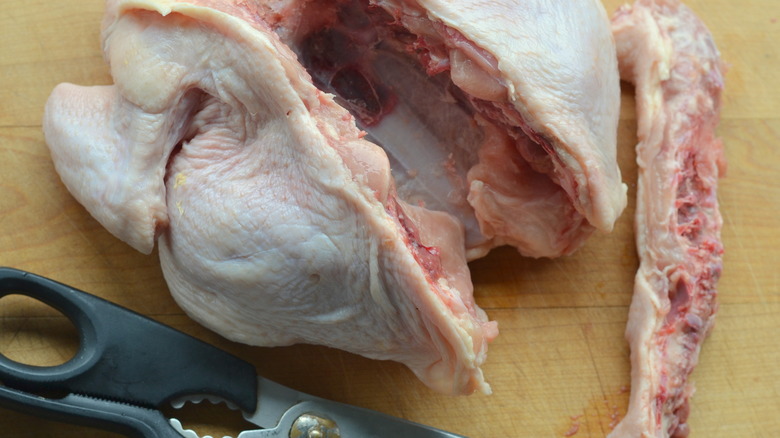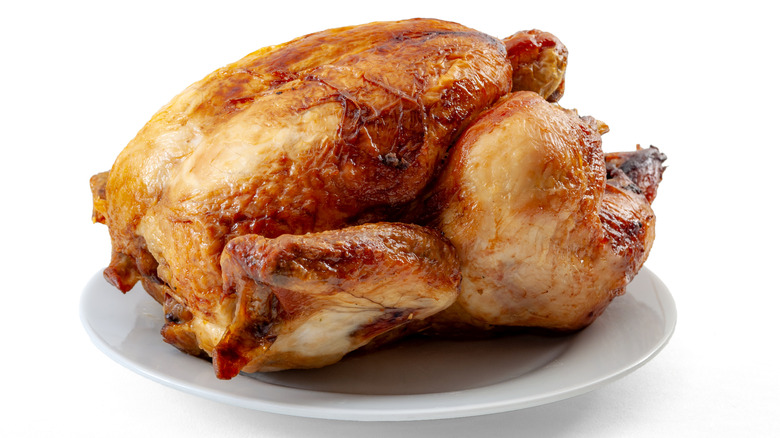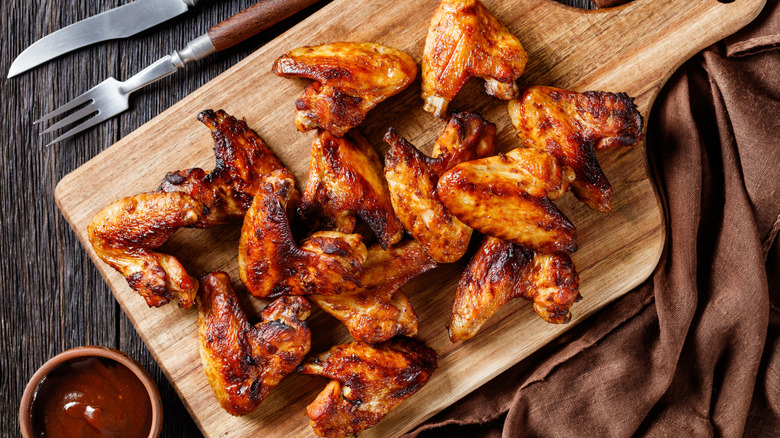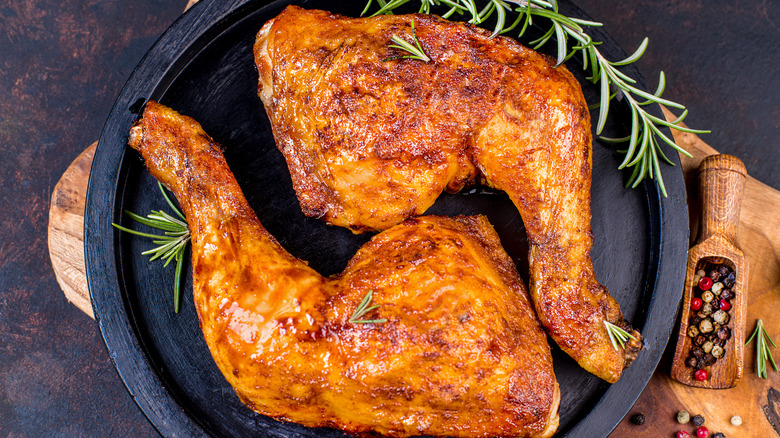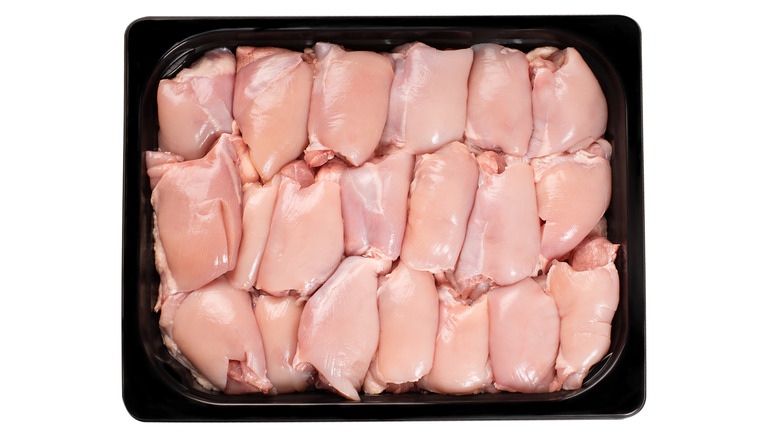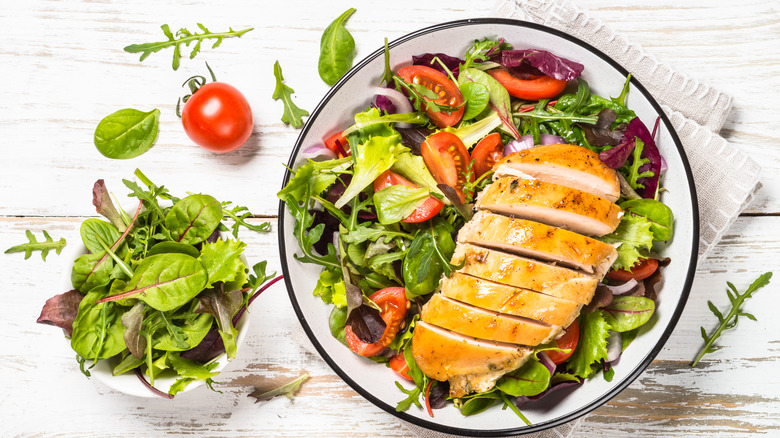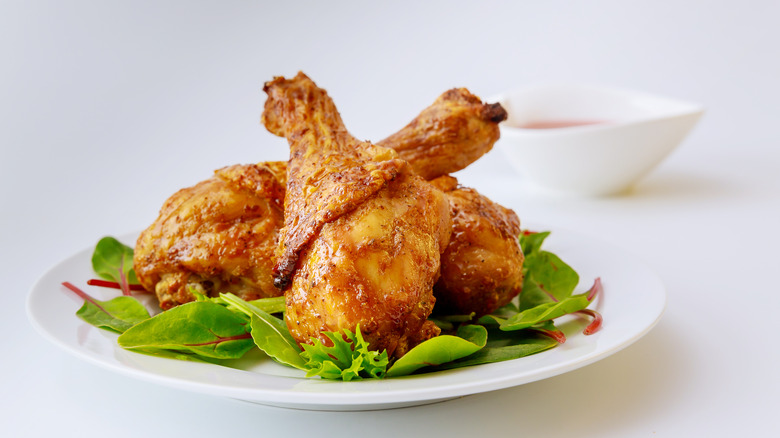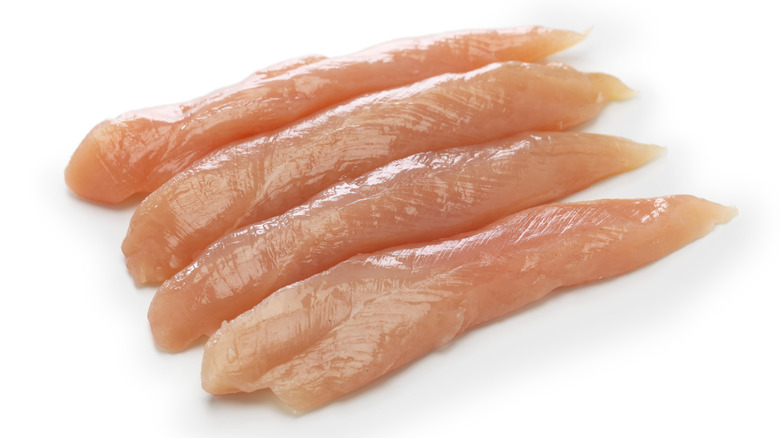The Ultimate Ranking Of Chicken Cuts
If you're picking up something for dinner from the meat aisle, you'll probably just grab a package of drumsticks or boneless chicken breast. Americans eat more chicken than any other meat, says the USDA, and it usually comes on styrofoam trays, neatly wrapped in plastic. But, we highly recommend you experiment with other parts of the bird, prepare the cuts in new ways, and experience new flavors.
Buying neatly packaged boneless chicken parts, or ordering nuggets at the drive-thru, makes it easy to disassociate the meal from the animal. In front of an audience of elementary school kids, Jaime Oliver explains each part of a chicken and how to cut them apart in a mission to show the next generation the difference between nutritious cuts and chicken nuggets. While the chef blends all the liver, bones, skin, and tendons to make little breaded patties, the kids gasp and scream in horror — but say they'd still eat the nuggets. The deep-fat-fried delicacies are tasty, after all.
Taking a whole animal and cutting it up into parts (or even just learning about them) can seem unappetizing. On the other hand, it's an opportunity to feel closer to your food and thankful to the chicken who provided it. We break down the various cuts of a chicken that are worth trying.
10. Giblets
You've purchased a whole chicken, and while you're dressing it to roast, you reach into the empty abdominal cavity and find a baggy of mysterious meaty objects. They are the giblets, and you must take them out before roasting your chicken. If you forget, the plastic will melt in the oven, making the giblets and whole chicken inedible. The package of giblets usually includes the heart, liver, and gizzard, according to the University of Arkansas, Division of Agriculture. Cooks prize them for making dressing, gravy, and flavorful chicken stock.
To cook your own, start by simmering them for about two hours. Once you have a delicious broth, take the giblets out. If you're making dressing, chop the giblets and mix them in with the cubes of bread, sautéed onion, and celery. Then, you can thicken the broth to make gravy or save it to use in soups and other dishes. You could also cook the chicken liver with veggies and pork to make Louisiana dirty rice or use an instant pot to make a chicken liver pate recipe, if you happen to have a pound of them.
Giblets might have fans and haters, but, they're a healthy addition to most diets. According to the USDA, chicken livers, in particular, are a natural way to increase iron intake, especially for young children at risk of anemia. Eating blended chicken liver is cheaper and more natural than buying iron supplements — whether it's more delicious is up to the chef.
9. Neck
If you live someplace with big box grocery stores, you've likely never encountered more than one chicken neck at a time. Butchering plants remove this part of the bird and put it in the bag with the giblets so it's easier to package, says the University of Michigan. People, in rural areas, who slaughter home-grown chickens, might have more chicken necks than they know what to do with. Turns out, this cut of chicken can turn out delicious.
Chefs in restaurants, who process many birds at once, can also end up with a pile of necks, says Chef Jacob Burton, who calls salt and pepper chicken necks one of his favorite Scooby snacks. He simply lies them out on a pan, seasons them, and bakes them. More commonly, home cooks throw the neck in simmering water with the carcass and some veggies to make some homemade stock.
While chicken necks don't feature in modern American cuisine, they show up in traditional recipes from other cultures. Consider trying some Jamaican chicken neck brown stew or trini geera chicken necks, a street food from Trinidad.
8. Backbone
A chicken backbone is foundational to flavor. NPR says that Hank Williams and later Johnny Cash found themselves in Mother Maybelle Carter's kitchen downing bowls of her famous chicken gizzard soup, which included the backbone of the bird. She is said to have served her soup with a side of musical advice. This may have been a formative moment for country music, but it's also a representation of how culturally important chicken soup is to food culture. The backbone of the bird is what helps provide the base.
If you're cutting up a whole chicken into parts, use shears to cut out the backbone and save it for making chicken stock, if you're not planning on making gizzard soup like Mother Maybelle. Alternatively, Chef Kenji Lopez-Alt keeps the bird whole, but still cuts out the backbone, so he can spatchcock it — in other words, spread the chicken flat for roasting. He recommends boiling the backbone with vegetables while the bird is in the oven. Then, thicken and add some wine to make a sauce.
7. Whole chicken
Buying a whole chicken is advantageous. You'll get all the cuts at a cheaper price. The disadvantage is that you'll have to process it, which means cutting it into breasts, tenderloins, legs, wings, and back, or you can prepare a roast chicken recipe. If you've chosen to roast, consider using the spatchcock method of cutting out the backbone and spreading the bird flat.
Chef Kenji Lopez-Alt says a traditional roast leaves the breast exposed to overcooking and becoming dry. Meanwhile, the legs and thighs, which require higher temperatures, remain tucked away and sometimes undercooked. By spreading the chicken flat, the breast is more protected and the legs more exposed. The result is an evenly-cooked entree.
Careful, though. The USDA says that not every whole chicken is the same as the next: If you purchase a broiler-fryer, weighing between 3 and 4 pounds, you can cook it in almost any way — fry, grill, roast, or cut up for other dishes. It will take around an hour and a half to roast in the oven. Roasting hens are larger at 5 to 7 pounds, and they have a longer cook time of two hours. If you need to feed a crowd, buy a capon. These chickens weigh around 7 pounds and their lighter, tenderer meat is perfect for roasting. You'll need three hours to cook one, through. If time is of the essence, get a cornish hen. They take just one hour to roast.
6. Wings
On Super Bowl Sunday, people in the U.S. eat around 1.45 billion chicken wings, according to the National Chicken Council — estimated to feed four wings to every man, woman, and child in the United States. They're fun finger food, perfect for dipping in any sauce, and shine at informal gatherings. Most people order wings from restaurants, but Chef Jamie Oliver says that chicken wings are one of the cheapest cuts to purchase if you want to make them yourself. After roasting or frying, wings are delicious and crispy. You can cook the upper part — called the drummette — separately.
Preparing wings in an air fryer is easy. Add salt, pepper, garlic powder, and a bit of oil, then, cook at 390 degrees Fahrenheit for 20 minutes. If you prefer roasting in the oven, it will take between 30 and 40 minutes. On the grill, calculate eight minutes per side. Wings can also go in the crockpot.
Our recipe for honey garlic chicken wings requires just five minutes of prep time. Then, stew on low for about six hours. Put them in at lunchtime, and they'll be ready for dinner.
5. Chicken legs
Chicken legs are the thigh and drumstick together. Purchasing the leg quarter is less common than buying the other two cuts separately. According to the USDA, the leg ranked 14th most popular in 2017, whereas drumsticks took second place, and thighs, third.
Purchasing the leg quarter has some benefits. For example, Chef Jamie Oliver says this cut looks beautiful when presented roasted whole on a platter. Maybe consider serving ras el hanout braised chicken legs for your next dinner party if you want to amaze your friends. On the other hand, legs have a slightly longer cooking time than drumsticks: 40 to 50 minutes instead of 35 to 45, says the USDA.
If you cook whole-leg quarters, you may find that the drumstick gets a little overdone while the thigh needs more time. If you're cutting a chicken into parts, you may want to leave the legs whole. Fewer cuts mean less processing time. Plus, a leg is a perfect portion size for freezing.
4. Thigh
Thighs may be Chef Jamie Oliver's favorite part of the chicken, or at least the bit he thinks is tastiest. Dark meat is juicier and firmer than the breast, and it's generally less expensive. It has more flavor, too. The bones in the thighs make them less comfortable to prepare and eat, though. Fortunately, most grocery stores sell boneless thighs. Keep in mind, boneless skinless thighs are more expensive per pound than boneless skinless breasts.
Cookbook author Ina Garten says she likes using thighs because when you pan-sear them, they stay moist. She says the key to getting thighs perfect is to cook them skin-side-down first for fifteen minutes — and leave them without moving.
Thighs are also delicious when roasted in the oven. Cook them for between 35 and 45 minutes. Consider this sheet-pan chicken paprikash with potatoes: It requires about 25 minutes of prep time and 45 minutes in the oven. It's the perfect lunch for a lazy Sunday.
3. Breast
Boneless chicken breast may be the easiest and fastest cut to prepare. Cook them whole by pan frying or cut breasts into strips to add to quesadillas, pot pies, rice dishes, and salads. You won't have to worry about running into any bones. If you make bite-size pieces, they'll be easy to eat, too. That's not all, according to WebMD, chicken breast is the healthiest part of the bird. It's no wonder that it was the most sold cut of chicken in 2017, says the USDA.
For all its popularity and ease of preparation, chicken breast has a huge downfall: It gets dry and tough when it's overcooked and it's not very flavorful, says Chef Billy Parisi. That means the breast will take on the taste of the seasoning, like this quick-griddled chicken with herbs. It's a wonderful way to showcase a tasty sauce like in this recipe for chicken balsamic.
Finally, if you need a quick solution for dinner, chicken breast is your best friend. Prep time can take as little as 15 minutes. Then, you'll just need to put it on the griddle for around 10 minutes.
2. Drumstick
Drumsticks are fantastic for kids (and adults). It's just a shame that the whole bird only comes with two because everyone ends up fighting over them. Little ones love grabbing drumsticks in their hands and biting the meat off. There's no need to use forks or knives. Drumsticks are better finger food than wings because there's more meat on them and far tastier than breast. You can even make a sauce for dunking them if you want.
Another benefit to making drumsticks is they're faster to cook than thighs, according to the USDA, only 35 to 45 minutes instead of 40 to 50. On the grill, they take just eight minutes per side.
If you make roasted drumsticks in the oven, you can spread about 15 out on a sheet and that's enough for dinner and leftovers. If barbeque is more your style, try making zesty bbq drumsticks. They'll make any backyard gathering a success.
1. Tenders
Chicken tenderloins (aka chicken fingers or tenders) are the best-kept, chicken-related secret in the history of mankind. According to the USDA, this cut ranked just 25th in popularity, but they are arguably the best part of the bird. Their low ranking may be because they're easily confused with breast and they're almost a dollar more per pound than breasts from popular grocers. Chicken tenders are a narrow strip of meat from beneath the breast. If you're cutting up a whole bird, you might not even realize that this is a distinct cut.
Tenders are the best cut of chicken because they combine positive characteristics of other cuts. They are moister than the breast but have a similar nutritional value, says cookbook author David Leite. If you bread them, they make fun finger food — just like wings and drumsticks — but you won't have to worry about gnawing on the bone.
Tenders are all meat. If that's not enough to convince you, tenders cook very quickly since they're so thin. If you're wondering how to prepare them, just pan-sear them like your favorite recipe for breasts or bread them to make a fried chicken recipe. You can't go wrong.
